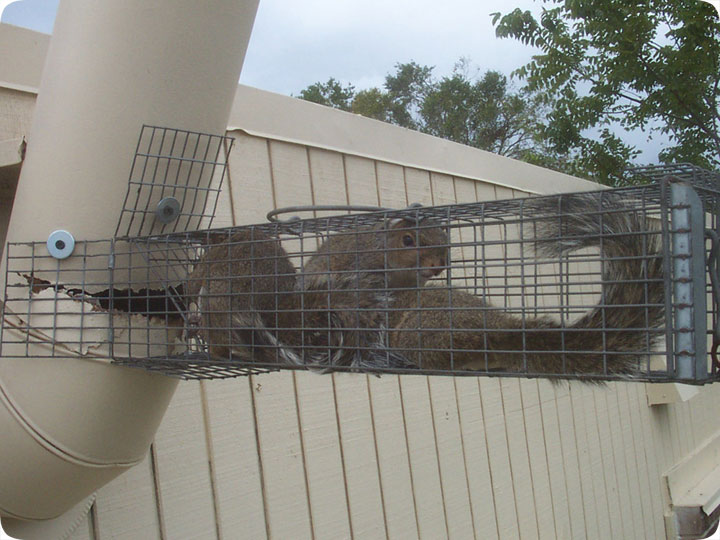-
info@aaanimalcontrol.com
Call us for help in your town
Humane Wildlife Education
Squirrels in a Vent Pipe

I came out to the building to inspect, but I had trouble finding an opening for squirrels to get into the building. Everything was sealed tight, no open holes or chewmarks. The only thing I saw amiss was a rip in a metal vent pipe. I thought that the pipe must be solid, with no opening into the attic, and I've never seen squirrels use such an area before, so I dismissed it at first. However, as it became clear to me that there were no other ways in, I decided to investigate more closely.
An inspection of the attic space above the drop ceiling revealed that the pipe did indeed have an opening. I put my ladder up to the roof, and sniffed around, and I smelled the dirty scent of sneaky squirrels. It was a tricky area to address, but I got out my metal drill, and I was able to bolt a repeater trap right on the pipe, as seen above.
I returned in about 16 hours, after the office called me to tell me that I'd caught some squirrels. I came out, and sure enough, I'd caught them. This trap holds up to five squirrels. I removed these three and reset the trap, but no more squirrels were caught. Looks like there were only three inside the building when I set the trap. If some were outdoors, they had no way to get back in. Thus, the problem was solved. I removed the trap and patched the hole with sheet metal, which I bolted in.
Do it yourself: Visit my How To Get Rid of Squirrels page for tips and advice.
Get professional help: Visit my Nationwide Pro Directory of wildlife removal experts.
Why Do Squirrels Go Into The Attic - Squirrels will go into the attic for two reasons, in general. One reason is that they have found an opening to get into the attic and are exploring it because they are just terribly curious creatures. The second reason is that they are seeking shelter. This shelter is not just for protection from rain and wind. They are seeking protection from predatory animals like foxes, or hawks or even snakes. They are also seeking to protect the next generation of squirrels from any harm. Squirrels have their litter in the attic where they will find peace and security. The squirrel female can make nice warm nests in attics for her young. Even if the attic is nothing more than a place under the roof, there is always insulation between rafters that she can use for cushioning her nest.
The squirrel female will be safe nursing her young in the attic, unlike having a nest in a tree or bush. She will be able to raise her babies in safety until they are ready to be taken outside and taught to fend for themselves, thus ensuring the survival of the next generation of squirrels, at least until they are able to feed themselves and run for their safety.
The Eastern Gray Squirrel (Sciurus carolinensis), is one of the most widespread nuisance animals in the country. It lives throughout most of the United States. It is arboreal (likes to live in trees), but just as commonly atticeal (likes to live in attics). It's a member of the rodent family, and is prone to chewing and gnawing. Squirrels are active during the daytime, particularly morning and evening. They are active year-round. They give birth to two litters of young per year, in late summer and late winter, commonly inside buildings they've chewed into. They are very agile and great climbers, and are active animals. They are cute, but often destructive, especially when they enter an attic.
For more wildlife stories, click my Wildlife Blog, or click my below banner to hire a local trapper.





















